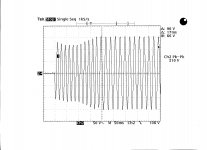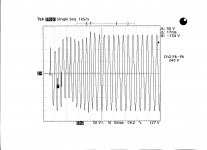I'd love to see a high power version for a Garrard 401 with adjustable output frequency/voltage for North America mains. It would be cool to use a 50hz pulley and still be able to adjust the frequency in slight increments up or down with North American mains. I think Garrard 301/401's need around 16-18 watts?... not sure on that one. Oh... and make it in red.... HA!..... just kidding
Whatever happens I'm sure it will be good.
Thanks
Frank M
Whatever happens I'm sure it will be good.
Thanks
Frank M
Count me in for the high power version as well. I'm working with the VPI HW-19 600RPM 10W motor.
If it matters, I would no longer need a high powered version. I assumed my table had the 10W motor, but I discovered it is in fact using a 5.5Watter.
Do you know why a moderator on the LENCO forum would compare the LENCO motor to a lawn mower?
I am confused. I use the LENCO motor with my table (the motor and the idler are about all that is left) and my speed stability is excellent.
Why would your device be akin to putting some sophisticated fuel injection system on a lawn mower engine any more than the motors used in the other tables mentioned?
I would think the VPI motor would be more like a lawn mower's. The LENCO motor is much more powerful and would have no need of power enhancements.
Just thought it was a strange comment and when I could not easily find the comment on the forum I thought I would ask. Just curious ...
I am confused. I use the LENCO motor with my table (the motor and the idler are about all that is left) and my speed stability is excellent.
Why would your device be akin to putting some sophisticated fuel injection system on a lawn mower engine any more than the motors used in the other tables mentioned?
I would think the VPI motor would be more like a lawn mower's. The LENCO motor is much more powerful and would have no need of power enhancements.
Just thought it was a strange comment and when I could not easily find the comment on the forum I thought I would ask. Just curious ...
Probably best if you ask him yourself, I don't want to make any false assumptions.
You can find the post Here by rfgumby (second post on page 2 of the thread).
I would never have found it there, that is for sure.
But I think you got it backwards. Seems to me that he is talking about the VPI motor not the LENCO being the needless recipient of your device.
Nonetheless, I think what you have come up with is quite good and no one can argue that you are very fair on the price.
If you were to make one with more output power I would want one. with the understanding that more power would cost more ...
My wish is for a Falcon version that offers a low-current output or internal access point(s). The purpose would be to create a three-phase supply.
regards, jonathan
This may be possible with the new high power version which will be 2 pcs. The controller will be a low power (5VPP) version of the Falcon. The output will be single phase only, you would have to do the other 2 phase shifts externally.
This may be possible with the new high power version which will be 2 pcs. The controller will be a low power (5VPP) version of the Falcon. The output will be single phase only, you would have to do the other 2 phase shifts externally.
No complaints with modular
Option A (needs two outputs from controller)
Controller output 1 -----------------------------> power output stage 1 (0 degrees)
Controller output 2 --> phase shifter output 1 --> power output stage 2 (120 degrees)
Controller output 2 --> phase shifter output 2 --> power output stage 3 (240 degrees)
Option B (needs only one output from controller)
Controller output 1 --> phase shifter output 1 --> power output stage 1 (0 degrees)
Controller output 1 --> phase shifter output 2 --> power output stage 2 (120 degrees)
Controller output 1 --> phase shifter output 3 --> power output stage 3 (240 degrees)
thanks, jonathan
The current prototype design is only single phase output. Not sure about selling the pcs separately, I didn't really envision this turning into a DIY project, plus inventory management gets more complicated. I did a hand built proto version of a low voltage 2 phase output for a colleague of mine in AU.
Is your interest commercial or DIY?
Is your interest commercial or DIY?
One single-phase output is fine. Per Option B in my previous post, I would design a suitable phase shifter, and use it to drive three output stages.
Initially my interest is for prototyping a turntable motor. Being able to use an existing, fully debugged controller and output stage would make more time and effort available for designing, building and testing the motor bearing, coils, and magnet system.
Also, I fully expect to fry an output stage or three during the prototyping process, so being able to replace a failed output stage with another ready-made spare unit would be convenient.
I expect this to be a lengthy project, and whether it will or will not advance beyond the prototyping stage, I do not know yet.
regards, jonathan
Initially my interest is for prototyping a turntable motor. Being able to use an existing, fully debugged controller and output stage would make more time and effort available for designing, building and testing the motor bearing, coils, and magnet system.
Also, I fully expect to fry an output stage or three during the prototyping process, so being able to replace a failed output stage with another ready-made spare unit would be convenient.
I expect this to be a lengthy project, and whether it will or will not advance beyond the prototyping stage, I do not know yet.
regards, jonathan
Sorry, it's difficult to tell from the photos but the control unit connects to the amp via a plug in cable, a 3.5mm stereo plug on each end. There is only one wall adapter to power the amp; the control unit receives its power over the cable that connects the two together.
The 60 hz motors are pretty rare.
Wondered if you got lucky.
Looks like you are getting close!
What about this one: Lenco Motor on e-Bay
What about this one: Lenco Motor on e-Bay
I have never been very good at finding things on EBAY!
A little more than I want to pay. Paid about that for the whole table five years ago.
I will patiently wait for your controller to be available. Rather send that money to you.
Thanks, nonetheless.
Received the Hurst motors yesterday and tested them with the new high power PSU. I ordered the 10W 600 RPM (found in some VPI Classics and HW19's) as well as a pair of 7.5W 300 RPM motors (Dual motor w/flywheel apps). The results were even better than with the Lenco motor.
The PSU heatsink temp topped out at 106°F with the 10W motor and stayed under 120°F with both 7.5W motors connected. The lower temps may be due to a higher power factor measured than with the Lenco motor.
I made an additional change to the start up procedure of the PSU when using a transformer output (as the high power version does). The output amp struggled with the core magnetization when it was started at full power and 50Hz, especially into a light (or no) load. To smooth things out, the frequency starts at 60Hz and minimum level for 100 mS until the the amp has stabilized. The level is then ramped up to full output voltage and the frequency shifted down to 50Hz for the soft start. From there it is ramped up in frequency to 60Hz (33.3 RPM) or 81Hz (45 RPM). This results in a very smooth start regardless of load.
The PSU heatsink temp topped out at 106°F with the 10W motor and stayed under 120°F with both 7.5W motors connected. The lower temps may be due to a higher power factor measured than with the Lenco motor.
I made an additional change to the start up procedure of the PSU when using a transformer output (as the high power version does). The output amp struggled with the core magnetization when it was started at full power and 50Hz, especially into a light (or no) load. To smooth things out, the frequency starts at 60Hz and minimum level for 100 mS until the the amp has stabilized. The level is then ramped up to full output voltage and the frequency shifted down to 50Hz for the soft start. From there it is ramped up in frequency to 60Hz (33.3 RPM) or 81Hz (45 RPM). This results in a very smooth start regardless of load.
Attachments
- Status
- This old topic is closed. If you want to reopen this topic, contact a moderator using the "Report Post" button.
- Home
- Vendor's Bazaar
- Digital Turntable Tachometer and DDS based PSU

